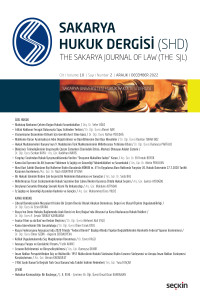Öz
i) The 'complexity science', which is based on the motivation that everything is connected with everything, so that all the pieces complete each other and form a singular system (integrated puzzle), has revealed a gestalt leap in natural and social sciences.
ii) Such that, in studies conducted without complexity analysis, subjects, equation intricacy and scale limit the solution considerably.
iii) After the complexity analysis transformed the natural sciences and computer techniques, the social sciences, which are the other sub-parts of the large system in a broad sense, entered the enlightenment age of complexity science. At this point, economics, law and sociology are the leading disciplines.
iv) There is no study in our Turkish literature that considers law as a complex adaptive system. Therefore, bringing the work, which was published in 2008 and accepted as a masterpiece in this field, into Turkish literature is a very important production activity.
v) In the masterpiece study, it is revealed that it is not possible to deal with the individual parts of the law as a system. So that each part is both the cause and the effect of all the other parts. Therefore, when dealing with a legal problem, it is proven how wrong our analyzes are by pulling out a piece and changing it and keeping everything else constant. Because even when a part is removed from the system and a small change is made to it, the system will come to a completely changed state with all the other parts.
vi) Some important motivations, patterns and patterns for solving this difficult and productive puzzle are explained.
Anahtar Kelimeler
law as a complex adaptative system law and complexity science law from the perspective of general equilbrium model intiution
Kaynakça
- Orijinal makale, alanında baş yapıt kabul edilen bir ürüne dair çeviri çalışmasıdır.
Öz
i)Her şeyin, her şey ile bağlantılı olduğu ve böylece tüm parçaların birbirini tamamlayarak bir tekil sistem (bütünleşik bulmaca) çıkardığına dair tespit ve motivasyon üzerine kurulu 'karmaşıklık bilimi', doğal ve sosyal bilimlerde bir gestalt sıçrama ortaya çıkarmıştır.
ii)Öyle ki karmaşıklık analizi olmadan analiz edilen sorunsalların özneleri, denklem giriftliği ve ölçeği çözümü oldukça kısıtlamaktadır.
iii)Karmaşıklık analizinin doğa bilimleri ve bilgisayar tekniğini dönüştürdükten hemen sonra, geniş anlamda büyük sistemin diğer alt parçaları olan sosyal bilimler de bir nevi karmaşıklık biliminin aydınlanma çağına girmiştir. Burada ekonomi, hukuk ve sosyoloji başı çeken disiplinlerdir.
iv)Türkçe literatürümüzde hukuku bir karmaşık uyarlanabilir sistem olarak ele alan bir çalışma mevcut değildir. 2008'de yayınlanan ve bu alanda başyapıt olarak kabul edilen çalışmanın Türkçe literatüre kazandırılması, önemli bir üretim faaliyeti olarak gördüm.
v)Ele alınan başyapıtta hukukun sistem olarak parçalarının tekil tekil ele alınmasının mümkün olmadığı ortaya konmaktadır. Öyle ki her parça, diğer tüm parçaların hem nedeni hem sonucudur. Dolayısıyla bir hukuksal problemi ele alırken bir parçayı çekip diğer her şeyi sabit tutarak yaptığımız analizlerin ne kadar hatalı olduğu ispat edilmektedir. Çünkü sistemde bir parçayı çıkarıp ona küçük bir değişim yapıldığında bile sistem diğer tüm parçalaryla artık tamamen değişmiş yeni bir duruma gelecektir.
vi)Bu zor fakat verimli bulmacada çözüme dair bazı önemli motivasyonlar, paternler ve örüntüler anlamlandırılmaktadır.
Anahtar Kelimeler
karmaşık uyarlanabilir sistem olarak hukuk karmaşıklık bilimi ve hukuk genel denge modelivari sezgide hukuk
Kaynakça
- Orijinal makale, alanında baş yapıt kabul edilen bir ürüne dair çeviri çalışmasıdır.
Ayrıntılar
| Birincil Dil | İngilizce |
|---|---|
| Konular | Hukuk |
| Bölüm | Çeviriler |
| Çevirmenler | |
| Yayımlanma Tarihi | 30 Aralık 2022 |
| Gönderilme Tarihi | 27 Ağustos 2022 |
| Yayımlandığı Sayı | Yıl 2022 Cilt: 10 Sayı: 2 |

The published articles in SLJ are licensed under a
Creative Commons Attribution-NonCommercial 4.0 International License

